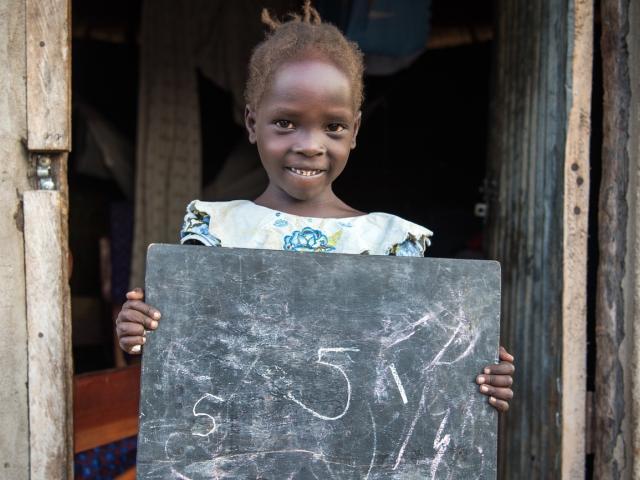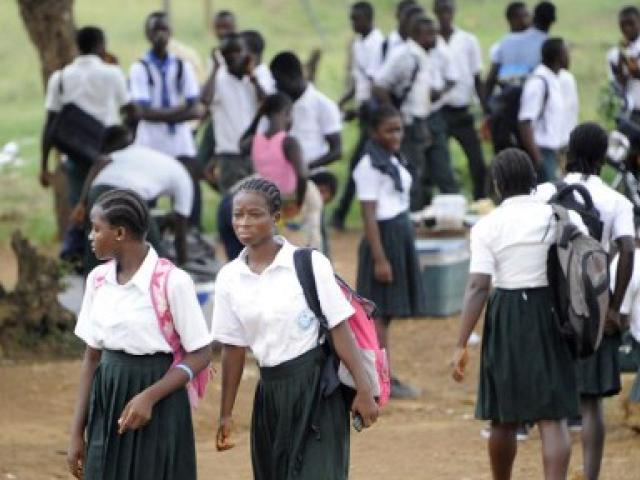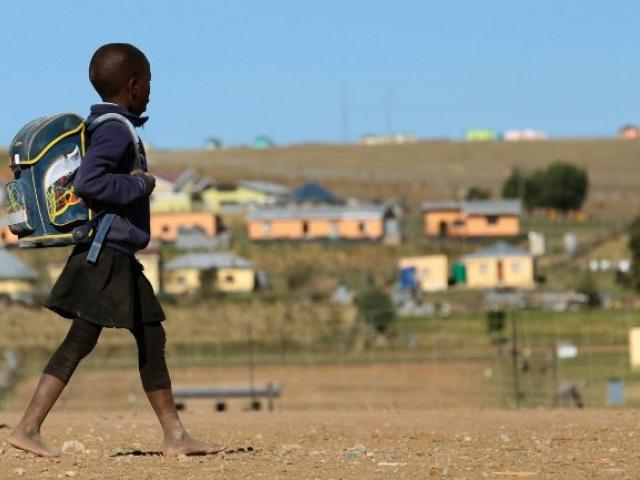This article is more than 6 years old
To highlight the difficulties women worldwide face in trying to get an education, anti-poverty campaign group ONE recently published a report comparing the situation in several countries.
“The toughest places for a girl to get an education” report ranked 122 countries and assessed women’s access to and quality of education.
Of the 10 countries with the lowest access, nine are in Africa, the organisation co-founded by popular rock musician Bono claimed. These are Burkina Faso, the Central African Republic, Chad, Ethiopia, Guinea, Liberia, Mali, Niger and South Sudan. Afghanistan was the only non-African country on this list.
“On average, women in these countries have spent less than two years of their lives in school,” ONE stated.
Does the available evidence support this startling claim?
To compile its index, ONE says it used 11 measures. These ranged from out-of-school girls and completion rates to government expenditure on education and average years of schooling for women older than 25 years.
The data had to be no older than from 2010, Yannick Tshimanga, a ONE spokesman told Africa Check. Data from UNESCO’s Institute for Statistics was the primary source for the rankings, he said. (Note: The institute is the official data agency of the United Nations Educational, Scientific and Cultural Organisation, providing internationally-comparable data on education.)
If information for a particular country or measure was missing, data from UNESCO household surveys and the World Inequality Database on Education was used, Tshimanga said.
In trying to verify the average number of years women spend in school, the mean years of schooling measure would be the best indicator to use, Friedrich Huebler, who is with the institute’s education standards and methodology section, told Africa Check.
Mean years of schooling provides an average of the number of completed years someone older than 25 spent in school.
Using ONE’s index and that provided by WIDE and the institute, Africa Check compiled this table:
Tshimanga said that according to their methodology, “on average, women go to school for less than two years”, at 1.99 years in the nine countries. (Note: The unrounded figures in ONE’s spreadsheet averages to 2.06 years.)
Because of this, some countries “will have more than the average” - Liberia, Chad and the Central African Republic.
“The other seven countries are below the average, such as in Guinea where the mean years of schooling for women is 0.73 years,” he added.
The UNESCO institute does not have estimates for three of the countries on the list, Anuja Singh, a programme specialist with the UN data agency, told Africa Check.
Some of the data is more than a decade old - for example, Chad’s was last updated in 2004. But these figures are still useful, Huebler said. This is because the mean years of schooling indicator considers such a large cohort (anyone in the country older than 25) that the estimates in the database change only minimally over a small number of years.
“It would be preferable to compare data from the same year, but this is more important for indicators that can change quickly from year to year because they are calculated for small cohorts, such as primary school enrollment rates,” Huebler noted.
Is it sound to plug in WIDE data where UIS data is missing? Institute for Statistics data considers women older than 25 while that from WIDE looks at women between 20 and 24, Nicole Bella, a senior statistician with UNESCO’S Global Education Monitoring Report, told Africa Check.
“The use of different age-groups explains why WIDE mean years of schooling are higher than UIS data since youth are more likely to be educated than older generations,” she said.
Rosa Vidarte, who is a researcher for WIDE, supported this. “Since younger people have more years of schooling nowadays than in the past, it makes sense that [WIDE has] higher numbers given the age range that we are calculating schooling for,” she told Africa Check.
Further, WIDE uses household surveys, Vidarte said, alluding to the UIS’ use of annual survey data. “Also, the years that we are calculating for and what UIS is calculating for are different.”
The institute’s Singh told Africa Check that while the datasets could be broadly complementary, “we do not support direct comparison”.
Saying educating girls can change the world, global anti-poverty group ONE zeroed in on 10 countries - nine in Africa - as the “toughest” for girls to learn in. On average, women in these countries spent less than two years in school, the group said.
The organisation used data from UNESCO’s Institute for Statistics and plugged gaps by using the World Inequality Database on Education.
Experts told Africa Check that since the two datasets measure different age-groups and use different approaches to collating information, it is not advisable to directly compare them.
The UNESCO institute does not have estimates for three of the countries on the list, while the average years of schooling based on WIDE data is about three years.
Elements of the claim are accurate, but it is presented in a way that is misleading. However, this does not take away from the fact that both databases consistently show low years of schooling for women in the highlighted countries.
Additional reading:
https://africacheck.org/reports/more-girls-in-south-sudan-likely-die-in-childbirth-than-finish-high-school/
https://africacheck.org/reports/are-liberian-girls-more-likely-to-be-a-wives-than-literate/
https://africacheck.org/reports/is-sas-education-system-the-worst-in-africa-not-according-to-the-data/
“The toughest places for a girl to get an education” report ranked 122 countries and assessed women’s access to and quality of education.
Of the 10 countries with the lowest access, nine are in Africa, the organisation co-founded by popular rock musician Bono claimed. These are Burkina Faso, the Central African Republic, Chad, Ethiopia, Guinea, Liberia, Mali, Niger and South Sudan. Afghanistan was the only non-African country on this list.
“On average, women in these countries have spent less than two years of their lives in school,” ONE stated.
Does the available evidence support this startling claim?
How was the ranking compiled?
To compile its index, ONE says it used 11 measures. These ranged from out-of-school girls and completion rates to government expenditure on education and average years of schooling for women older than 25 years.
The data had to be no older than from 2010, Yannick Tshimanga, a ONE spokesman told Africa Check. Data from UNESCO’s Institute for Statistics was the primary source for the rankings, he said. (Note: The institute is the official data agency of the United Nations Educational, Scientific and Cultural Organisation, providing internationally-comparable data on education.)
If information for a particular country or measure was missing, data from UNESCO household surveys and the World Inequality Database on Education was used, Tshimanga said.
| What do the different data sources capture? The World Inequality Database on Education relies on a variety of surveys: demographic and health, multiple indicator cluster, national household and learning achievement surveys. This data is used in UNESCO’s annual Global Education Monitoring Report, Nicole Bella, a senior statistician for the annual study, told Africa Check. WIDE’s mean years of schooling measure provides data for people aged between 20 and 24. The Institute for Statistics obtains its data from annual questionnaires completed by officials of national statistics offices and education departments, Anuja Singh, an analyst with the data institute, told Africa Check. The UIS is not involved in the production of WIDE data, but the two datasets “can be complimentary”, Singh said. |
Average years of schooling ‘best indicator’
In trying to verify the average number of years women spend in school, the mean years of schooling measure would be the best indicator to use, Friedrich Huebler, who is with the institute’s education standards and methodology section, told Africa Check.
Mean years of schooling provides an average of the number of completed years someone older than 25 spent in school.
Using ONE’s index and that provided by WIDE and the institute, Africa Check compiled this table:
| Average years of schooling for women in 9 African countries | |||||
| ONE | UIS | WIDE | |||
| Country | Years in index | Years | Last update | Years | Last update |
| Burkina Faso | 0.95 | 0.95 | 2014 | 2.07 | 2010 |
| Central African Republic | 3.88 | - | - | 3.88 | 2010 |
| Chad | 2.15 | 0.68 | 2004 | 3.16 | 2014 |
| Ethiopia | 1.23 | 1.23 | 2011 | 5.07 | 2016 |
| Guinea | 0.73 | 0.73 | 2010 | 3.81 | 2012 |
| Liberia | 5.63 | - | - | 5.65 | 2013 |
| Mali | 1.31 | 1.31 | 2015 | 2.47 | 2012 |
| Niger | 1.32 | - | - | 1.32 | 2012 |
| South Sudan | 1.37 | 3.97 | 2008 | 1.37 | 2010 |
Tshimanga said that according to their methodology, “on average, women go to school for less than two years”, at 1.99 years in the nine countries. (Note: The unrounded figures in ONE’s spreadsheet averages to 2.06 years.)
Because of this, some countries “will have more than the average” - Liberia, Chad and the Central African Republic.
“The other seven countries are below the average, such as in Guinea where the mean years of schooling for women is 0.73 years,” he added.
Estimates do not change rapidly from year to year
The UNESCO institute does not have estimates for three of the countries on the list, Anuja Singh, a programme specialist with the UN data agency, told Africa Check.
Some of the data is more than a decade old - for example, Chad’s was last updated in 2004. But these figures are still useful, Huebler said. This is because the mean years of schooling indicator considers such a large cohort (anyone in the country older than 25) that the estimates in the database change only minimally over a small number of years.
“It would be preferable to compare data from the same year, but this is more important for indicators that can change quickly from year to year because they are calculated for small cohorts, such as primary school enrollment rates,” Huebler noted.
‘Direct comparison’ not advisable
Is it sound to plug in WIDE data where UIS data is missing? Institute for Statistics data considers women older than 25 while that from WIDE looks at women between 20 and 24, Nicole Bella, a senior statistician with UNESCO’S Global Education Monitoring Report, told Africa Check.
“The use of different age-groups explains why WIDE mean years of schooling are higher than UIS data since youth are more likely to be educated than older generations,” she said.
Rosa Vidarte, who is a researcher for WIDE, supported this. “Since younger people have more years of schooling nowadays than in the past, it makes sense that [WIDE has] higher numbers given the age range that we are calculating schooling for,” she told Africa Check.
Further, WIDE uses household surveys, Vidarte said, alluding to the UIS’ use of annual survey data. “Also, the years that we are calculating for and what UIS is calculating for are different.”
The institute’s Singh told Africa Check that while the datasets could be broadly complementary, “we do not support direct comparison”.
Conclusion: The claim is misleading
Saying educating girls can change the world, global anti-poverty group ONE zeroed in on 10 countries - nine in Africa - as the “toughest” for girls to learn in. On average, women in these countries spent less than two years in school, the group said.
The organisation used data from UNESCO’s Institute for Statistics and plugged gaps by using the World Inequality Database on Education.
Experts told Africa Check that since the two datasets measure different age-groups and use different approaches to collating information, it is not advisable to directly compare them.
The UNESCO institute does not have estimates for three of the countries on the list, while the average years of schooling based on WIDE data is about three years.
Elements of the claim are accurate, but it is presented in a way that is misleading. However, this does not take away from the fact that both databases consistently show low years of schooling for women in the highlighted countries.
Additional reading:
https://africacheck.org/reports/more-girls-in-south-sudan-likely-die-in-childbirth-than-finish-high-school/
https://africacheck.org/reports/are-liberian-girls-more-likely-to-be-a-wives-than-literate/
https://africacheck.org/reports/is-sas-education-system-the-worst-in-africa-not-according-to-the-data/





Add new comment